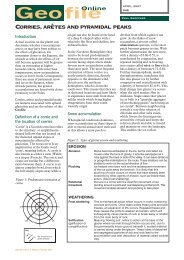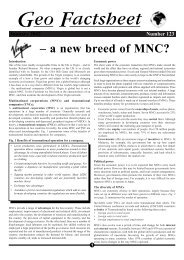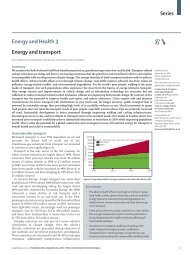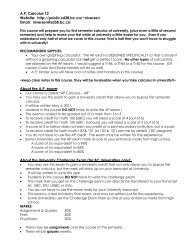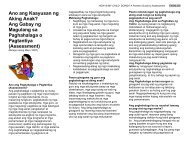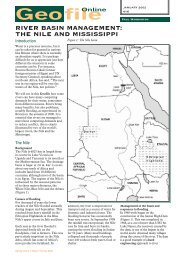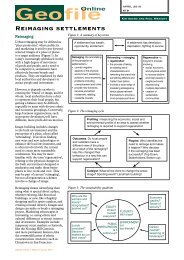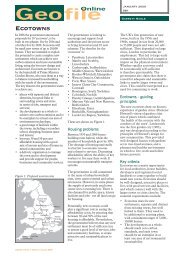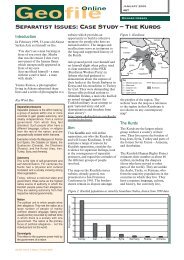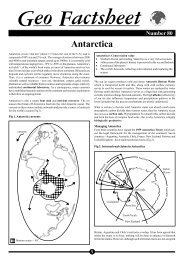25 Energy flow- Rainforests.pdf - Richmond School District No. 38
25 Energy flow- Rainforests.pdf - Richmond School District No. 38
25 Energy flow- Rainforests.pdf - Richmond School District No. 38
Create successful ePaper yourself
Turn your PDF publications into a flip-book with our unique Google optimized e-Paper software.
<strong>Energy</strong> Flow and Nutrient Recycling in Tropical <strong>Rainforests</strong><br />
Geo Factsheet<br />
<strong>No</strong>te: GPP is extremely high in TRF but R is<br />
also high because of the huge plant biomass<br />
which the photosynthesising tissues have to<br />
support. Despite this, NPP is still greater than<br />
in almost all other ecosystems on earth ( algal<br />
beds and reefs are commonly greater).<br />
Primary consumers (herbivores) gain their energy<br />
by eating the primary producers (the plants).<br />
Since primary production is high in the TRF, the<br />
numbers and biomass (dry weight per unit area<br />
e.g. mg/m 2 ) of primary, secondary and tertiary<br />
consumers which this primary production<br />
supports, is also high.<br />
Tropical Rain Forests contain more species of<br />
animals than any other ecosystem on earth. Food<br />
chains and webs are complex, but as in all other<br />
ecosystems, animals gain their energy by<br />
consuming plants (herbivores) or other animals<br />
(carnivores) or both (omnivores). This transfer<br />
of energy is not efficient. When an ant eats a leaf<br />
it gains only a fraction of the energy which was<br />
contained in the leaf. This is due to:<br />
1. The ant not eating all the leaf<br />
2. The ant immediately using some energy<br />
through respiration as it eats the leaf<br />
3. The ant losing some of the energy contained<br />
in the leaf because it couldn’t digest the leaf<br />
- the undigested material is passed out of the<br />
ant as faeces<br />
These three types of energy loss - through not<br />
all of the food source being eaten, through<br />
respiration and through faeces - occur at all<br />
subsequent stages of the food chain. It is precisely<br />
because of this energy loss that the number and<br />
biomass of organisms at each feeding level<br />
(trophic level) decrease.<br />
To summarise, energy <strong>flow</strong>s through the TRF<br />
ecosystem (Fig 2)<br />
Fig 2. <strong>Energy</strong> Flow<br />
SUN<br />
<strong>Energy</strong> lost as heat during respiration<br />
Primary<br />
Producer<br />
1% of chemical<br />
energy transferred<br />
when eaten<br />
Primary<br />
Consumer<br />
1% of chemical<br />
energy transferred<br />
when eaten<br />
Secondary<br />
Consumer<br />
1% of chemical<br />
energy transferred<br />
when eaten<br />
Tertiary<br />
Consumer<br />
<strong>Energy</strong> lost as heat during respiration<br />
Decomposers<br />
Chemical energy lost in faeces<br />
Nutrient inputs and outputs<br />
Nutrients dissolved in rainwater represent an<br />
important input. Most rainfall contains ions such<br />
as nitrate (NO 3-<br />
) but, in any case, rainfall<br />
penetrating the canopy may leach nutrients out<br />
of the foliage or out of algae and will wash insect<br />
deposits (frass) off leaves. It is also clear that,<br />
whilst some nutrients are removed from the<br />
foliage by rainfall, other nutrients are actually<br />
absorbed from the rainfall by leaves, aerial roots<br />
and epiphytes. The result is that the<br />
concentration of nutrients in the throughfall<br />
(water reaching the soil) is often very different<br />
from that of the original rainfall.<br />
Decomposition of leaves, twigs, fruits, <strong>flow</strong>ers,<br />
dead animals and faeces releases minerals into<br />
the soil. Such minerals may be leached or<br />
absorbed by plant roots. The top 20-30<br />
centimetres of soil contains a dense network of<br />
fine roots which are capable of absorbing soluble<br />
nutrients extremly rapidly. Some tree species<br />
have very deep tap roots which recapture leached<br />
nutrients which would otherwise be effectively<br />
lost to the system. The pattern of nutrient input<br />
and output is summarised in Fig 3.<br />
Nutrient cycles<br />
Nutrients - inorganic substances such as nitrogen<br />
(N), phosphorus (P), potassium (K) and calcium<br />
(Ca) - are found in the soil and litter. Nutrients<br />
are cycled between these three stores. Usually<br />
this is shown in the form of a <strong>flow</strong> diagram,<br />
where the size of the circles represents the<br />
amount of nutrients in a store and the width of<br />
the arrows between the circles represents the<br />
importance of each type of nutrient transfer.<br />
The common perception is that most nutrients<br />
of a TRF are in the biomass, with the least<br />
biomass in the soil. This is an oversimplification<br />
2<br />
but nevertheless this is the pattern which all<br />
candidates must be able to describe and explain<br />
(Fig 4 overleaf).<br />
Exam Exam Hint Hint -- Candidates Candidates frequently frequently show show<br />
great great confusion confusion about about tropical tropical soils. soils. Some Some<br />
clearly clearly believe believe that that they they are are all all very very deep deep<br />
and and nutrient nutrient rich, rich, others others indicate indicate that that all all<br />
TRF TRF soils soils are are shallow shallow and and nutrient nutrient<br />
deficient. deficient. The The truth truth is is more more complex complex and and<br />
good good candidates candidates will will show show the the examiners examiners<br />
that that they they appreciate appreciate this this. (see Fig 5).<br />
Figure 5 shows the distribution of inorganic<br />
nutrients above and below ground in three TRF<br />
areas. Table 2 summarises the principles<br />
underlying nutrient cycling and their implications<br />
for sustainable management.



